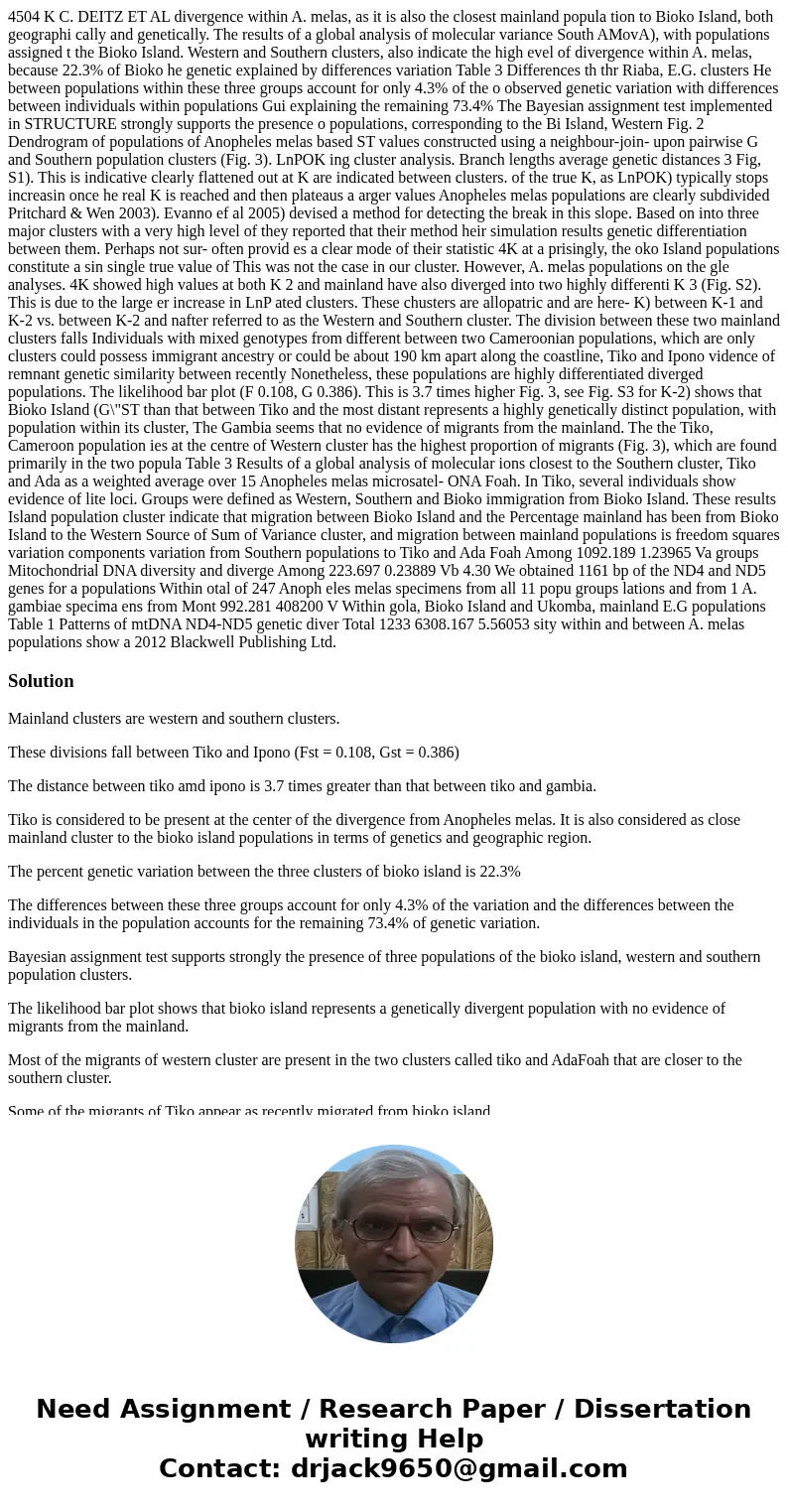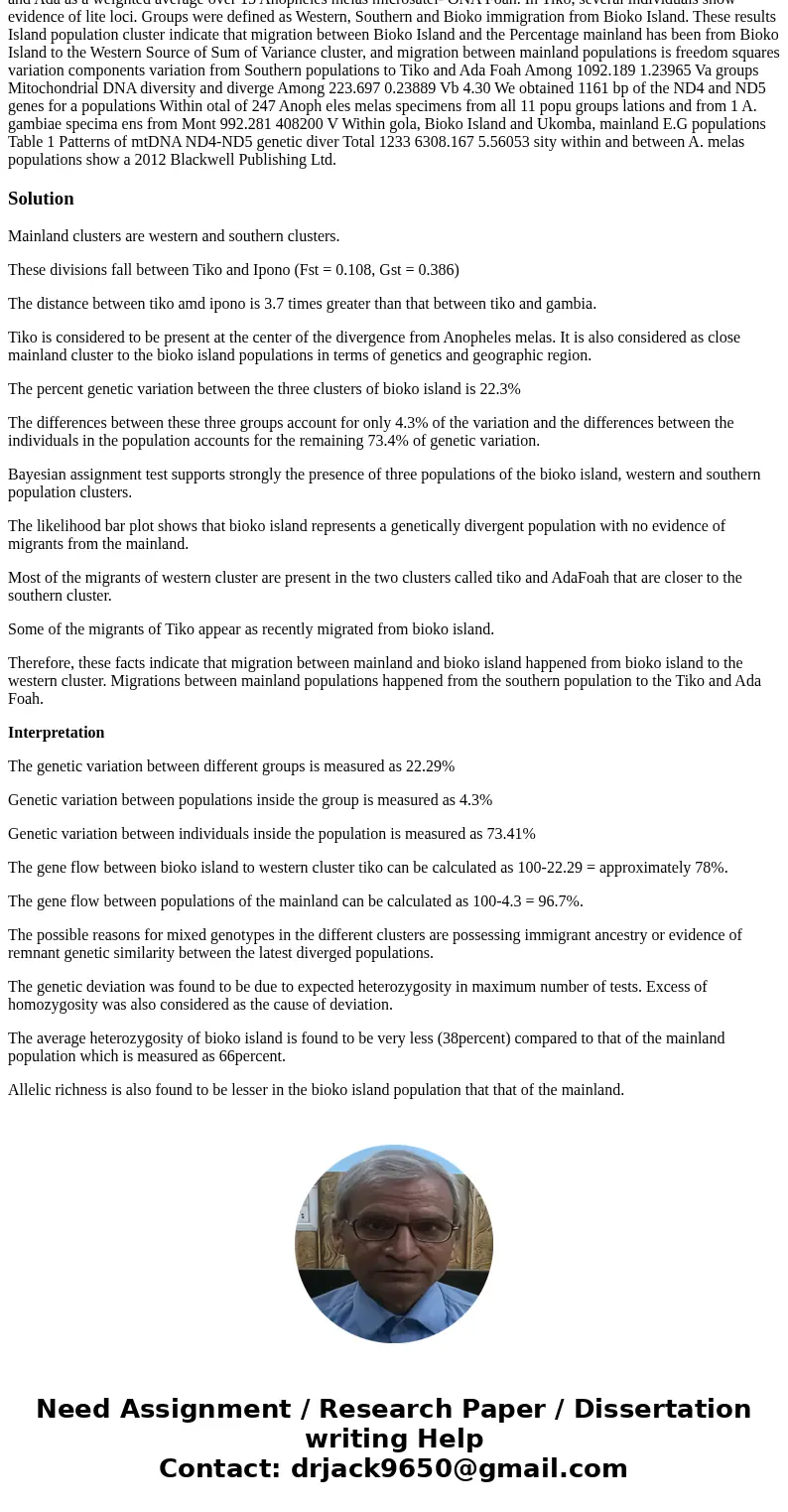4504 K C. DEITZ ET AL divergence within A. melas, as it is also the closest mainland popula tion to Bioko Island, both geographi cally and genetically. The results of a global analysis of molecular variance South AMovA), with populations assigned t the Bioko Island. Western and Southern clusters, also indicate the high evel of divergence within A. melas, because 22.3% of Bioko he genetic explained by differences variation Table 3 Differences th thr Riaba, E.G. clusters He between populations within these three groups account for only 4.3% of the o observed genetic variation with differences between individuals within populations Gui explaining the remaining 73.4% The Bayesian assignment test implemented in STRUCTURE strongly supports the presence o populations, corresponding to the Bi Island, Western Fig. 2 Dendrogram of populations of Anopheles melas based ST values constructed using a neighbour-join- upon pairwise G and Southern population clusters (Fig. 3). LnPOK ing cluster analysis. Branch lengths average genetic distances 3 Fig, S1). This is indicative clearly flattened out at K are indicated between clusters. of the true K, as LnPOK) typically stops increasin once he real K is reached and then plateaus a arger values Anopheles melas populations are clearly subdivided Pritchard & Wen 2003). Evanno ef al 2005) devised a method for detecting the break in this slope. Based on into three major clusters with a very high level of they reported that their method heir simulation results genetic differentiation between them. Perhaps not sur- often provid es a clear mode of their statistic 4K at a prisingly, the oko Island populations constitute a sin single true value of This was not the case in our cluster. However, A. melas populations on the gle analyses. 4K showed high values at both K 2 and mainland have also diverged into two highly differenti K 3 (Fig. S2). This is due to the large er increase in LnP ated clusters. These chusters are allopatric and are here- K) between K-1 and K-2 vs. between K-2 and nafter referred to as the Western and Southern cluster. The division between these two mainland clusters falls Individuals with mixed genotypes from different between two Cameroonian populations, which are only clusters could possess immigrant ancestry or could be about 190 km apart along the coastline, Tiko and Ipono vidence of remnant genetic similarity between recently Nonetheless, these populations are highly differentiated diverged populations. The likelihood bar plot (F 0.108, G 0.386). This is 3.7 times higher Fig. 3, see Fig. S3 for K-2) shows that Bioko Island (G\"ST than that between Tiko and the most distant represents a highly genetically distinct population, with population within its cluster, The Gambia seems that no evidence of migrants from the mainland. The the Tiko, Cameroon population ies at the centre of Western cluster has the highest proportion of migrants (Fig. 3), which are found primarily in the two popula Table 3 Results of a global analysis of molecular ions closest to the Southern cluster, Tiko and Ada as a weighted average over 15 Anopheles melas microsatel- ONA Foah. In Tiko, several individuals show evidence of lite loci. Groups were defined as Western, Southern and Bioko immigration from Bioko Island. These results Island population cluster indicate that migration between Bioko Island and the Percentage mainland has been from Bioko Island to the Western Source of Sum of Variance cluster, and migration between mainland populations is freedom squares variation components variation from Southern populations to Tiko and Ada Foah Among 1092.189 1.23965 Va groups Mitochondrial DNA diversity and diverge Among 223.697 0.23889 Vb 4.30 We obtained 1161 bp of the ND4 and ND5 genes for a populations Within otal of 247 Anoph eles melas specimens from all 11 popu groups lations and from 1 A. gambiae specima ens from Mont 992.281 408200 V Within gola, Bioko Island and Ukomba, mainland E.G populations Table 1 Patterns of mtDNA ND4-ND5 genetic diver Total 1233 6308.167 5.56053 sity within and between A. melas populations show a 2012 Blackwell Publishing Ltd.
Mainland clusters are western and southern clusters.
These divisions fall between Tiko and Ipono (Fst = 0.108, Gst = 0.386)
The distance between tiko amd ipono is 3.7 times greater than that between tiko and gambia.
Tiko is considered to be present at the center of the divergence from Anopheles melas. It is also considered as close mainland cluster to the bioko island populations in terms of genetics and geographic region.
The percent genetic variation between the three clusters of bioko island is 22.3%
The differences between these three groups account for only 4.3% of the variation and the differences between the individuals in the population accounts for the remaining 73.4% of genetic variation.
Bayesian assignment test supports strongly the presence of three populations of the bioko island, western and southern population clusters.
The likelihood bar plot shows that bioko island represents a genetically divergent population with no evidence of migrants from the mainland.
Most of the migrants of western cluster are present in the two clusters called tiko and AdaFoah that are closer to the southern cluster.
Some of the migrants of Tiko appear as recently migrated from bioko island.
Therefore, these facts indicate that migration between mainland and bioko island happened from bioko island to the western cluster. Migrations between mainland populations happened from the southern population to the Tiko and Ada Foah.
Interpretation
The genetic variation between different groups is measured as 22.29%
Genetic variation between populations inside the group is measured as 4.3%
Genetic variation between individuals inside the population is measured as 73.41%
The gene flow between bioko island to western cluster tiko can be calculated as 100-22.29 = approximately 78%.
The gene flow between populations of the mainland can be calculated as 100-4.3 = 96.7%.
The possible reasons for mixed genotypes in the different clusters are possessing immigrant ancestry or evidence of remnant genetic similarity between the latest diverged populations.
The genetic deviation was found to be due to expected heterozygosity in maximum number of tests. Excess of homozygosity was also considered as the cause of deviation.
The average heterozygosity of bioko island is found to be very less (38percent) compared to that of the mainland population which is measured as 66percent.
Allelic richness is also found to be lesser in the bioko island population that that of the mainland.


 Homework Sourse
Homework Sourse